The last pandemic caused by influenza A virus began in 1968. Reading the Weekly Epidemiological Records of the WHO then you can follow step by step the course of the pandemic. A few months after the end of the first and second season is the guide of influence in the world. I set the record for Canada, the U.S. and Europe in a table to compare the onset, the time of the peak and the end of the epidemic in different countries and also, where it was shown, the impact of the pandemic. This table is at the end of this post.
all begins in mid-July, 1968 in Hong Kong. There is an epidemic of flu that affects people of all ages. The virus is isolated and it turns out that this is a new strain of influenza A.
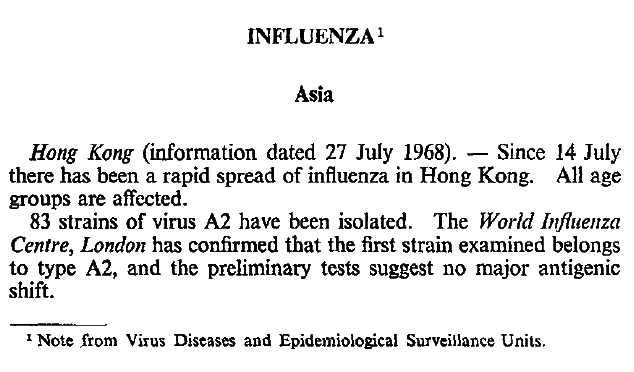
Source: Weekly Epidemiological Records, August 16, 1968
Fonte: Weekly Epidemiological Records, 3 gennaio 1969
I primi lotti di vaccino sono pronti a novembre ma per avere una quantità adeguata si deve aspettare ancora qualche mese. Con le prime dosi prodotte devono essere vaccinate le persone a maggiore rischio: gli anziani, le donne incinte e pazienti con malattie croniche cardio-vascolari polmonari o metaboliche.
The virus begins to move to other countries:
Preliminary data of the antigenic characteristics are confirmed by more rigorous examination
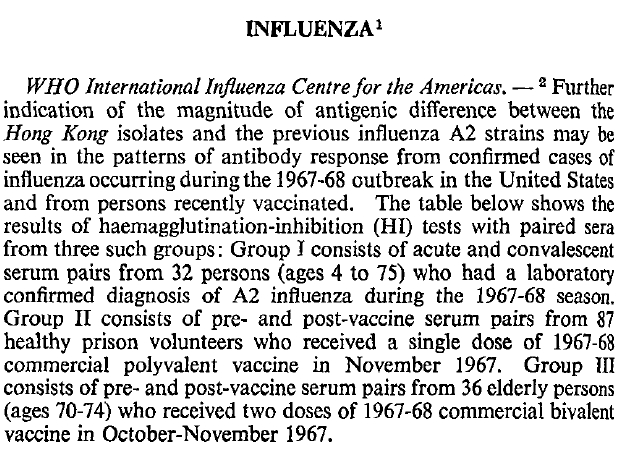
Fonte: Weekly Epidemiological Records, 6 settembre 1968
L'influenza arriva alle Philippine. I casi sono generalmente di natura benigna e complicazioni solo molto rare.
Anche in Cina i casi sono benigni e finora non sono stati riportati casi di morte.
Fonte: Weekly Epidemiological Records, 13 settembre 1968
Nelle ultime due settimane di agosto 11 su 40 membri dell'equipaggio di una nave che torna da Saigon ed è diretta a Vancouver si ammalano di sindrome influenzale. L'esame degli anticorpi conferma che la malattia è stata causata dal virus della nuova influenza. Anche a Londra you register the first case, a girl of 1 year and a half after her mother has the same symptoms.
Source: Weekly EPIDEMIOLOGICAL Records, September 27, 1968
The virus is carried by a ship sailing from Singapore on board with 16 patients in Madras in India. The epidemic is expanding rapidly. Other countries are reached by the virus.
In the U.S. there are alcuni focolai. La malattia è clinicamente benigna. Sempre più paesi vengono visitati dal virus.
Nel Regno Unito alla fine di settembre c'è un focolaio di influenza in una scuola. Anche qui la malattia si presenta benigna e gli adulti, tranne una persona, non si ammalano.
Siamo al 15 novembre. In Svezia una persona proveniente dall'India importa il virus ma trasmette la malattia solo ad un membro della famiglia. Non si registrano altri casi.
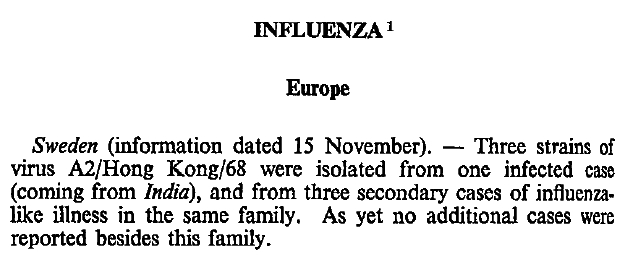
Negli USA il virus comincia a provocare le prime epidemie. A Needles in California si ammalano da 300 a 500 persone su un totale di 5000 residenti. I sintomi sono mal di gola, febbre, profondo malessere, mialgia adenopatia cervicale. La malattia dura tra una e due settimane. In Colorado i casi di sindrome influenzale aumentano da 62 a 670 and 656 respectively in the next two weeks.
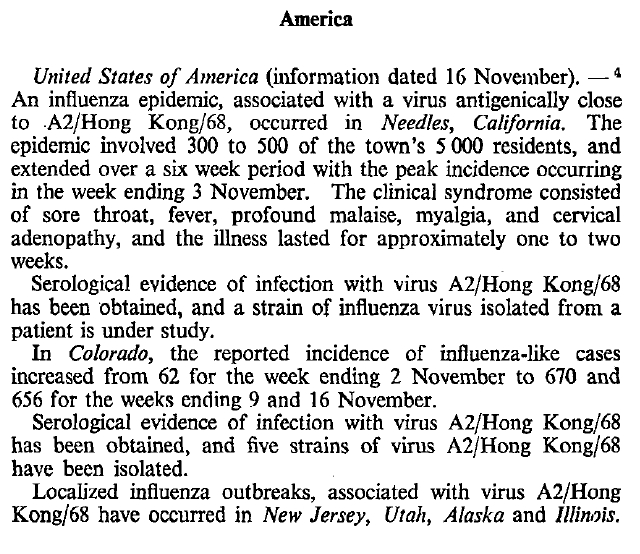
in Puerto Rico are reported 51,658 cases in the period from September 7 to November 16, but the epidemic is less intense epidemic caused by influenza season in January 1968.
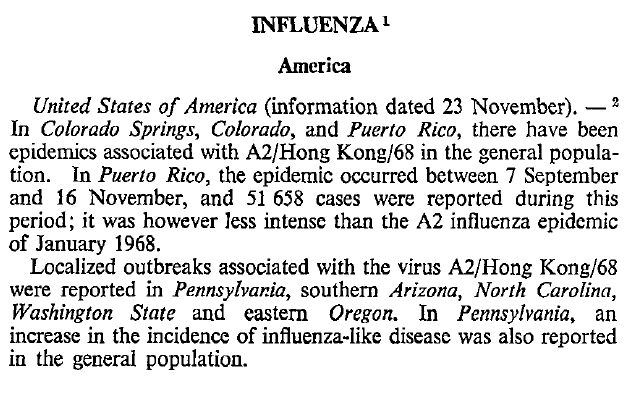
In Holland, the five family members become ill and it seems the infection has spread.
In Iceland there are some sporadic cases.
In Holland, meanwhile, the epidemic spreads across the country. There are some cases of death, but in most cases the disease appears benign.
In Germany there is an outbreak with 17 cases in a military station. Probably imported from a soldier who had returned from the USA. The disease is benign and has not spread in the population.
In the U.S., the epidemic is declining. Although it is difficult to determine the number of deaths directly associated with the virus, some cases of death caused directly by the virus in apparently healthy young people have been reported. The cause of death: pneumonia caused by viral or bacterial superinfection.
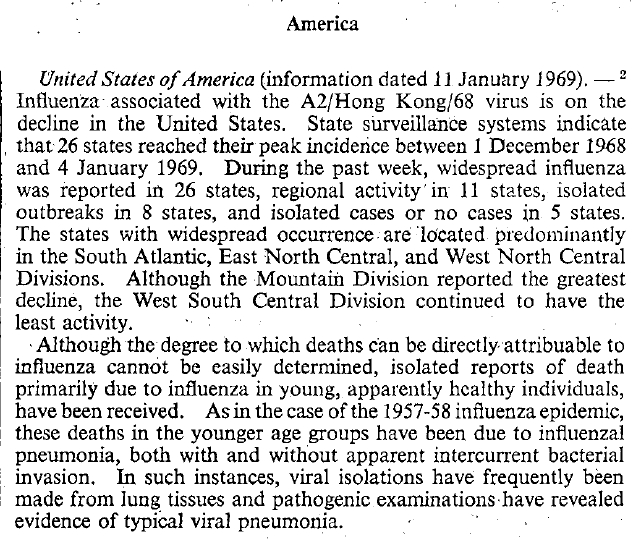
The virus arrives in Finland, Switzerland ...
Source: Weekly Epidemiological Reports, January 24, 1969
... and in Poland and Germany. In Sweden, the epidemic spreads from 900 to 1600 in the first week in the second to third week in 2480. Here too, the disease occurs in most patients with benign.
In Finland the epidemic spreads. The adults get sick more often than children. The disease is generally benign.
In Holland, the influence is benign or moderate. There are fewer complications of the previous flu season (the season).
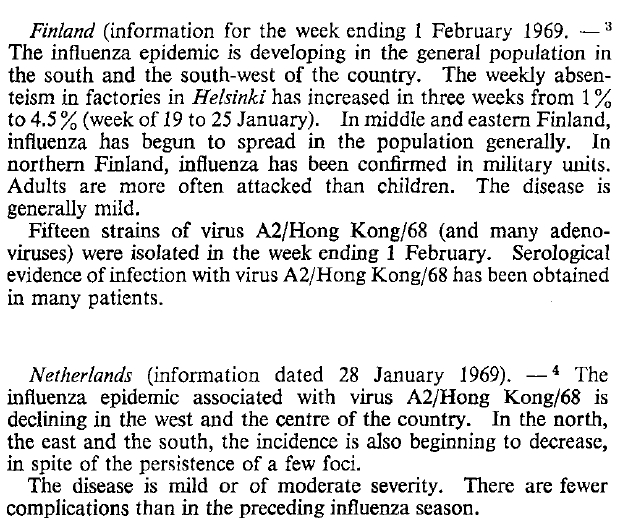
Source: WER , February 7, 1969
In the U.S. the number of cases continues to decline. In the UK the disease is widespread but the number of deaths does not suggest that the disease has often a severe clinical picture. For example last week of January were 53 reported cases of death and the preceding week. The maximum was reached in the week ending January 17 with 61 deaths. In January the previous mortality ranged from 993 in the first week of January to 215 last.
In Sweden, the epidemic is still increasing. We are at 11,500 cases, double the previous week. The disease continues to be benign.
Source: WER , February 14, 1969
In Finland, the epidemic wave is about to fall. The disease remains benign.
In France, the epidemic is beginning. The clinical picture shows benign or moderate.
In Germany, the virus has spread across the country but the incidence is normal or low. The disease is benign.
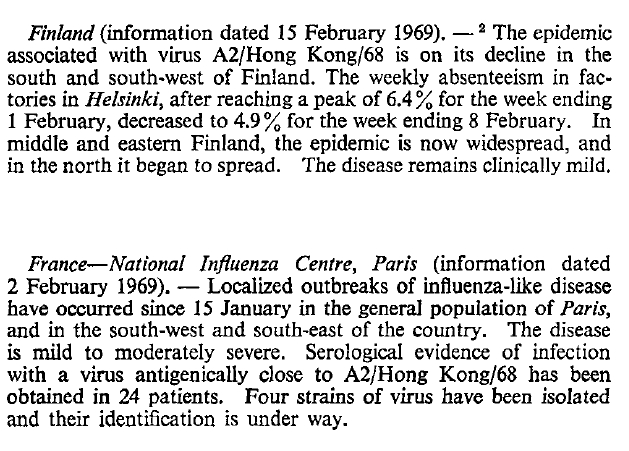
Anche in Czecoslovaccia è arrivata la pandemia e anche qui la malattia si presenta generalmente benigna.
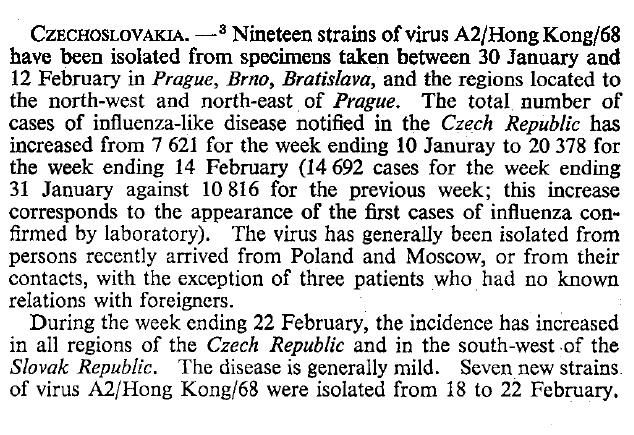
Fonte: WER, 28 febbraio 1969
In Polonia il 25% dei casi di malattia sono giovani adulti. La malattia è generalmente benigna.
Fonte: WER, 7 marzo 1969
Also in Bulgaria and France, the disease is described as benign.
In Italy there are only sporadic cases.
Source: WER , March 14, 1969
In Spain only the pandemic arrives in mid-March.
In France there are only a few deaths in the elderly.
In Hungary, the disease is benign.

In the United Kingdom were recorded 448 deaths in the first otto settimane della pandemia, in confronto a 3761 morti nel periodo corrispondente dell'anno precedente alla pandemia.
Fonte: WER, 21 marzo 1969
L'epidemia è finita in Finlandia ed anche in Svezia ci sono molto meno casi.
Invece in Jugoslavia i casi aumentano.
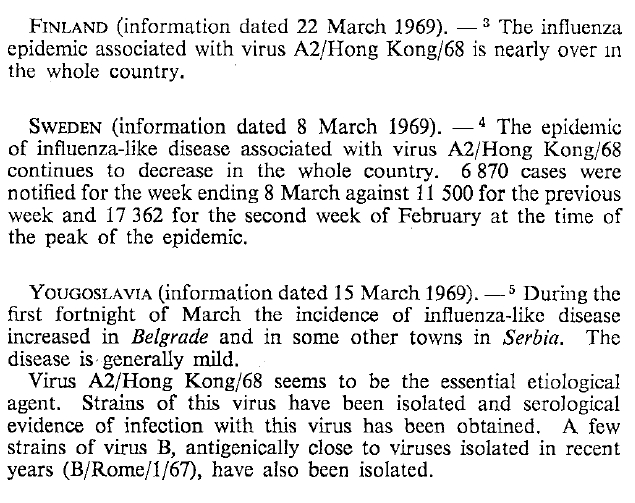
Fonte: WER, 28 marzo 1968
In Germania il picco è stato superato. I casi di morte sono stati rare. In addition to the new influenza virus circulate other viruses.
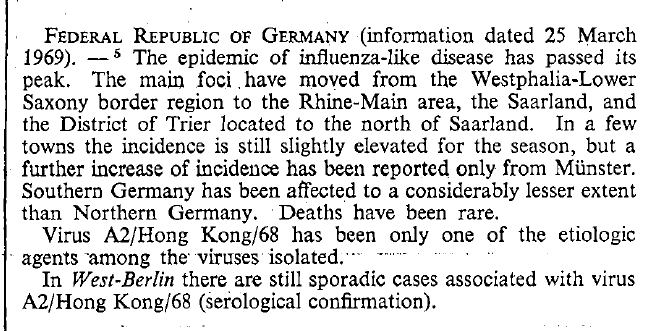
the end of March in the UK there are still many outbreak. In the week ending March 14 with the reported deaths are 110. In the week before were 100 and 76 in the week before.
Source: WER , April 3, 1969
In Spain the number of cases decreases in Barcelona but still increasing in other areas. The disease is clinically benign.
In the UK, the dead are still slightly increased over the previous week, sono 118.
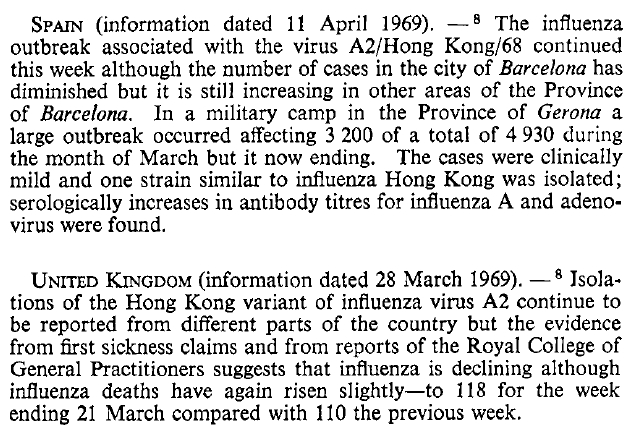
Fonte: WER, 18 aprile 1969
Ora, in Europa, la pandemia è finita.
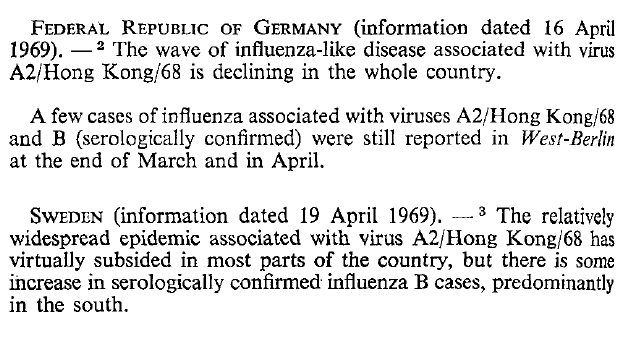
Fonte: Weekly Epidemiological Report, 2 maggio 1969
Il 10 aprile 1970 nel Weekly Epidemiological Records è stato pubblicato il riassunto del primo anno di pandemia. Ho preparato una tabella e da questa un Pdf document data regarding Canada, the USA and Europe.
In summary states that the WER in the U.S. there has been a major epidemic with a significant increase in mortality from pneumonia-influenza. If we compare the excess mortality with the corresponding period of the pandemic of 1957/58, the severity was identical. This experience was unique and did not occur in other countries with temperate climate in America. For example, in Canada the incidence of flu was only slightly higher than the reference years and there are virtually nessun'eccesso mortality.
In Europe, the number of cases of flu began to increase at the beginning of 1969, that the latest U.S. and high incidence of cases continued to be observed until April. Almost all European countries reported outbreaks but the extent varied. The largest outbreaks have occurred in Poland and Holland. There have also been outbreaks in Bulgaria, Czecoslovaccia, in parts of BRD, Finland, Hungary, Iceland, Sweden and some parts of the USSR. In these countries the disease was benign and was not observed a significant excess mortality. In the other countries of the infection was apparently more widespread, but sometimes the number of requests for sickness was only slightly higher than the usual. Even in these countries did not registered a significant excess mortality. For example, the United Kingdom, where the epidemiological surveillance was good, it is shown that the infection was common and widespread but clinically severe. Other European countries also reported that the epidemic was primarily caused local outbreaks and spread of the disease is relatively slow and not explosive like you usually see with the flu.
Now I start to do the same job for the second year of a pandemic, which was in many countries significantly heavier than the first year.
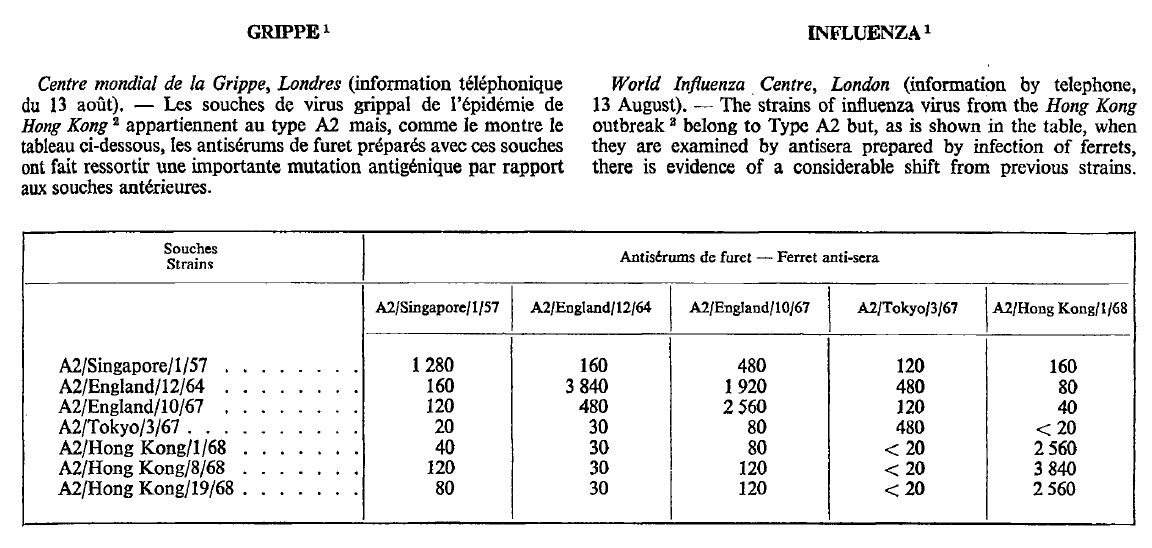
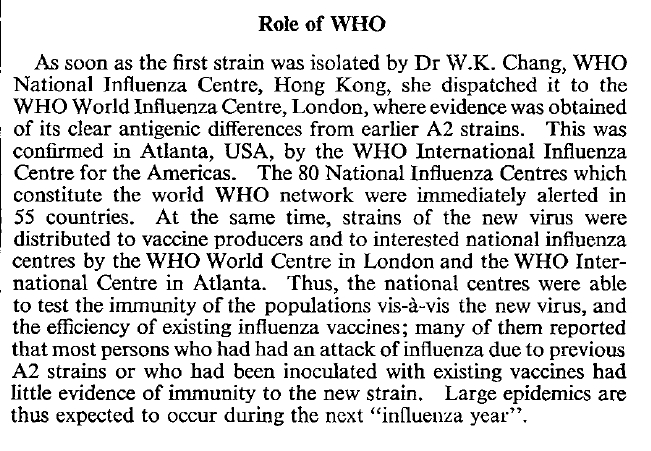

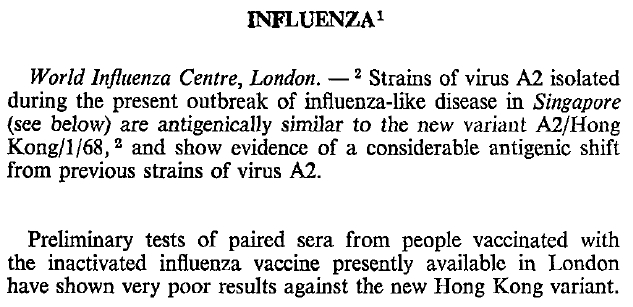
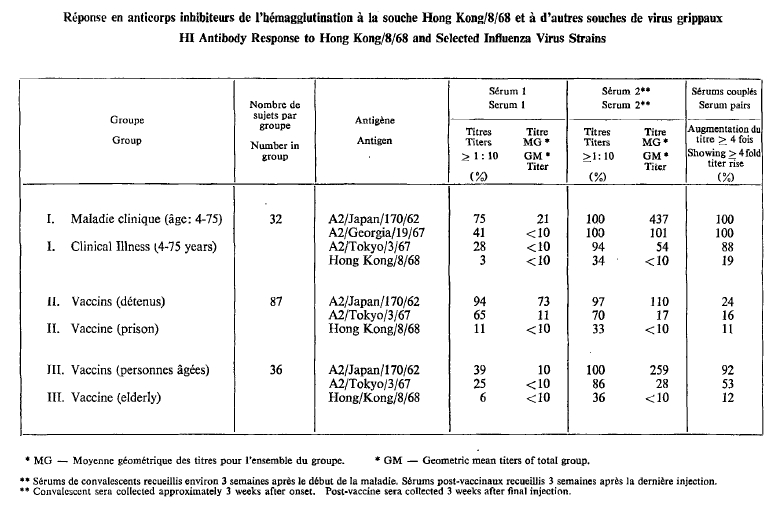

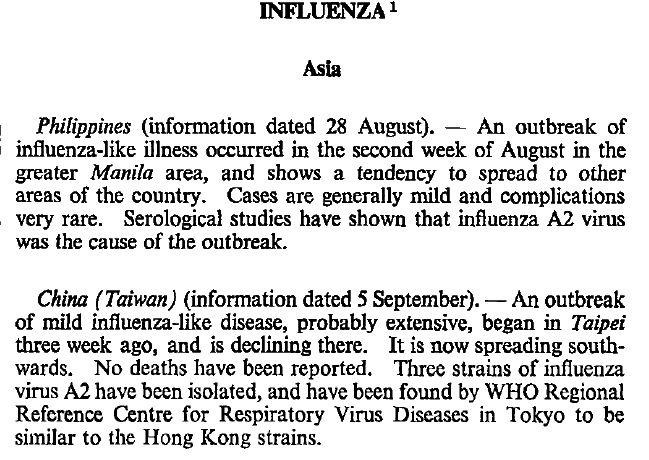
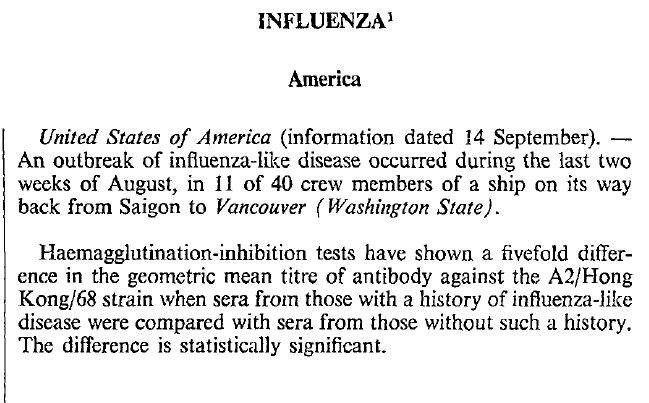
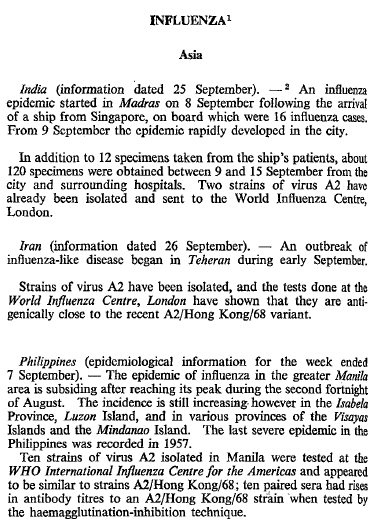

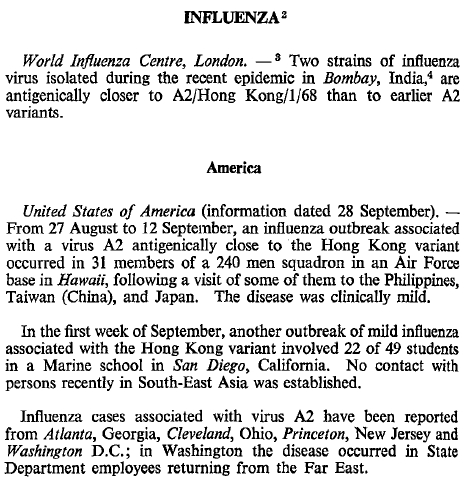

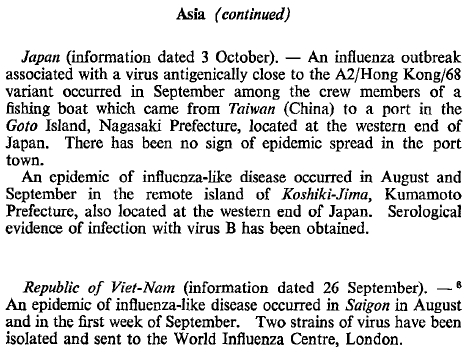
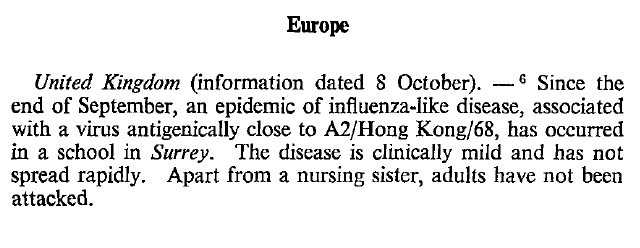
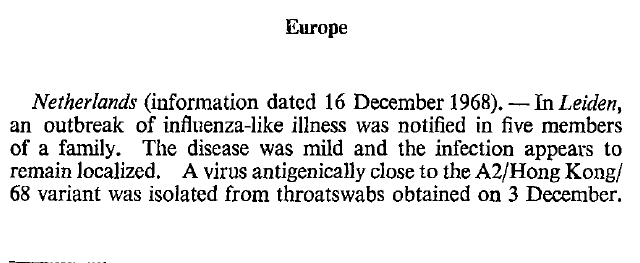
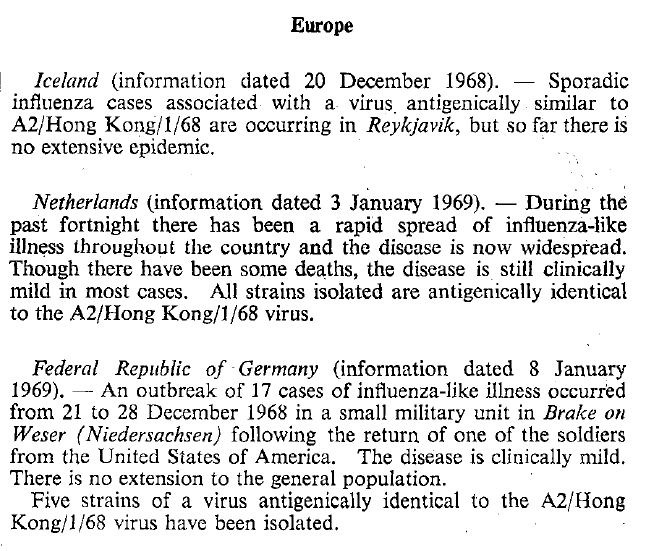
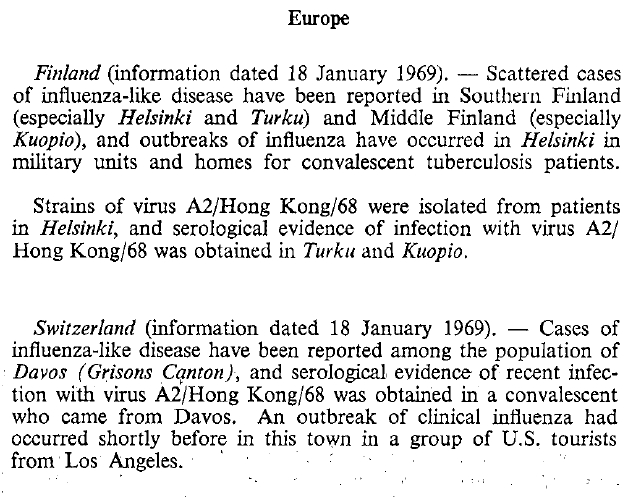
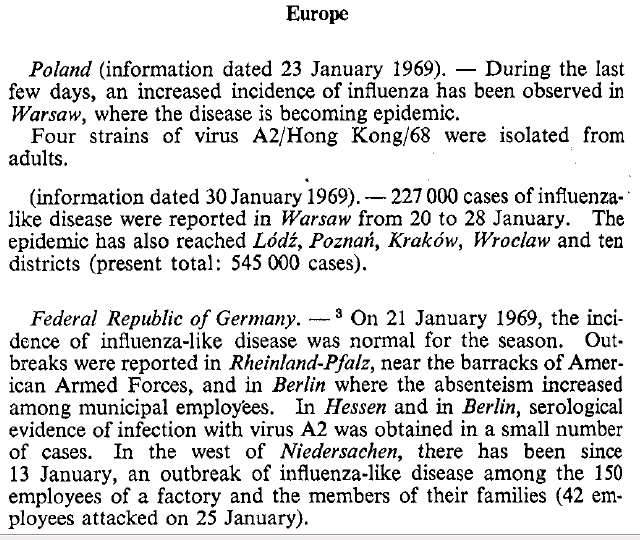
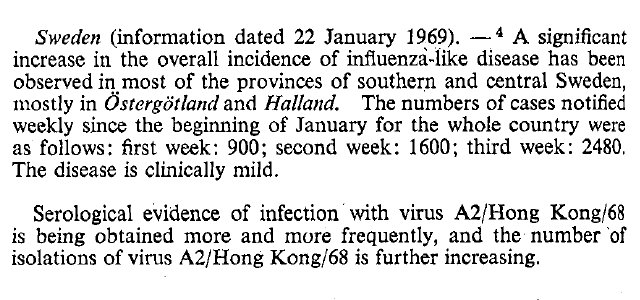

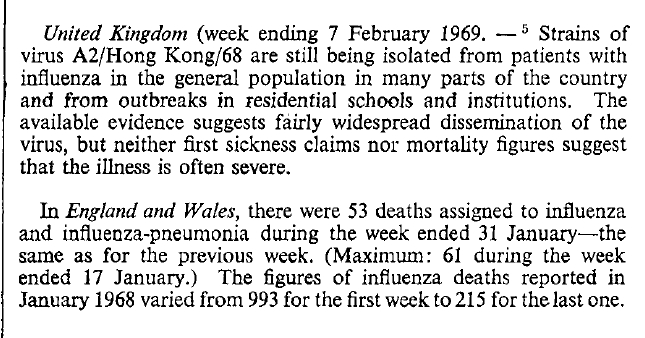
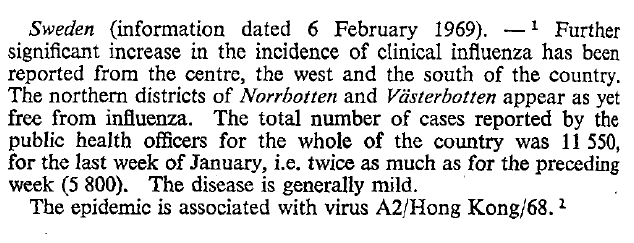
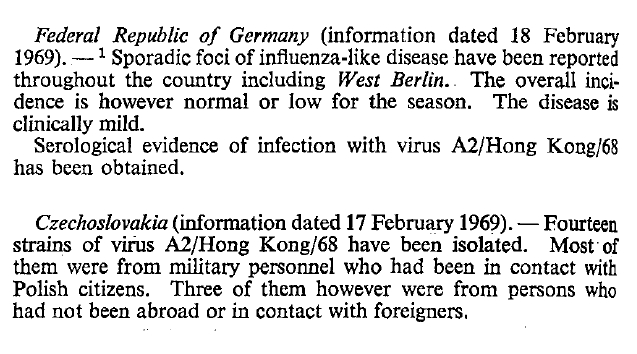
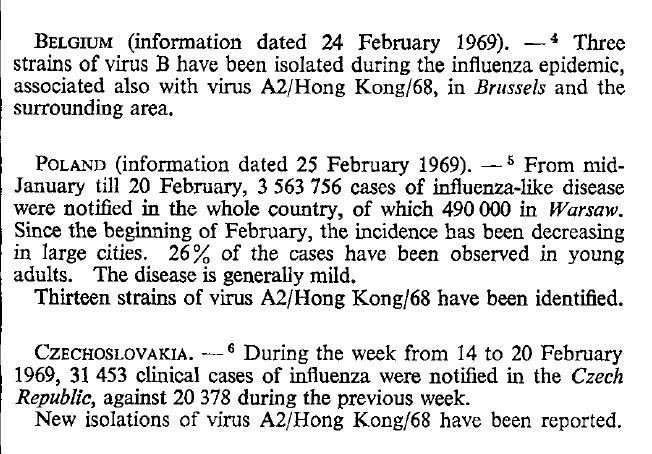

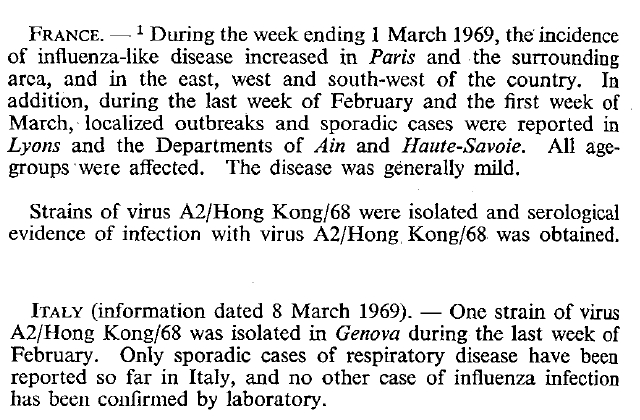
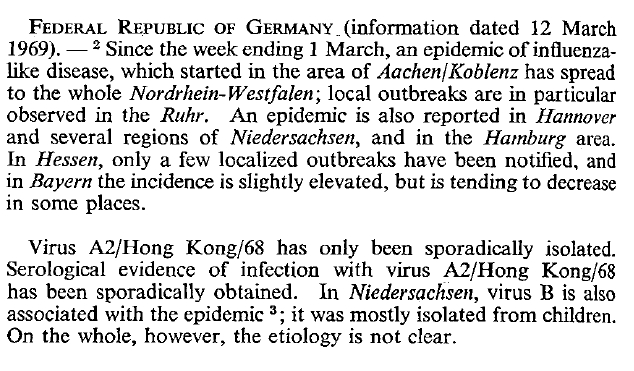
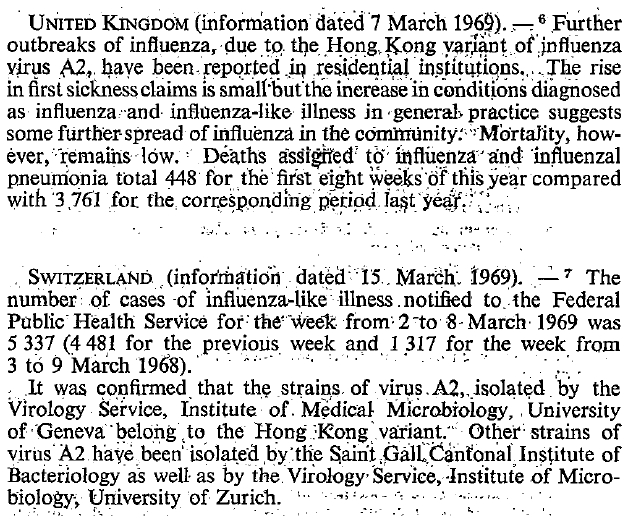
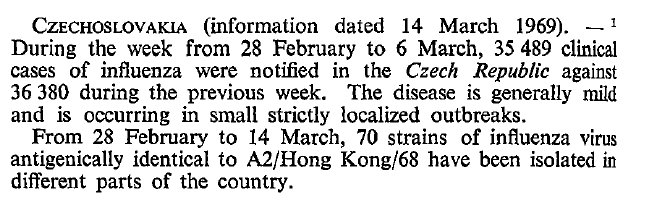
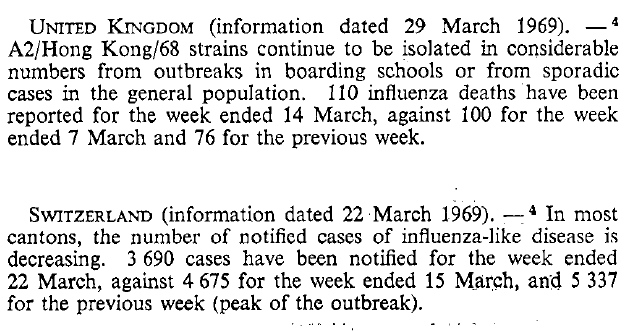
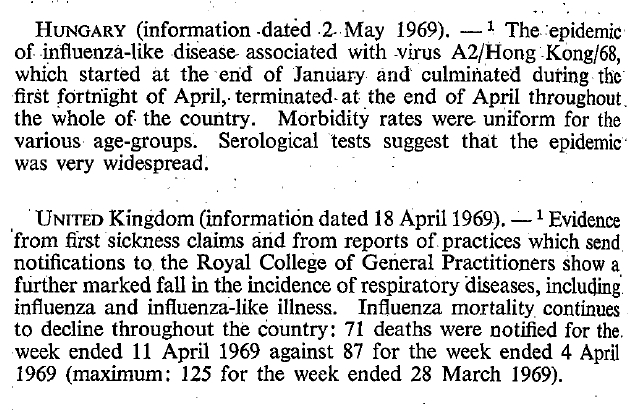
0 comments:
Post a Comment